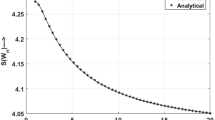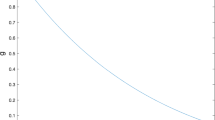Abstract
It is known that beyond \(2 \otimes 2\) and \(2 \otimes 3\) dimensional quantum systems, Peres–Hordecki criterion is no longer sufficient as an entanglement detection criterion as there are entangled states with both positive and negative partial transpose (PPT and NPT). Further, it is also true that all PPT entangled states are bound entangled states. However, in the class of NPT states, there exist bound entangled states as well as free entangled states. All free/useful/distillable entanglements are part of the class of NPT entangled states. In this article, we ask the question that given an NPT entangled state in \(3 \otimes 3\) dimensional system as a resource, how much entanglement can we broadcast so that resource still remains NPT. We have chosen \(3 \otimes 3\) system as a first step to understand broadcasting of NPT states in higher dimensional systems. In particular, we find out the range of broadcasting of NPT entanglement for two-parameter class of states (TPCS) and isotropic states (IS). Interestingly, as a derivative of this process we are also able to locate the existence of absolute PPT (ABPPT) states in \(3 \otimes 3\) dimensional system. Here we implement the strategy of broadcasting through approximate cloning operations.


Similar content being viewed by others
References
M Mohseni et al, Nat. News 543, 171 (2017)
R Won, Nat. Phot. 13, 77 (2019)
R Bedington, J M Arrazola and A Ling, Quantum Inf. 3(1), 30 (2017)
C H Bennett et al, Phys. Rev. Lett. 70, 1895 (1993); R Horodecki, M Horodecki and P Horodecki, Phys. Lett. A 222, 21 (1996)
M Hillery, V Buzek and A Berthiaume, Phys. Rev. A 59, 1829 (1999); S Sazim et al, Quantum Inf. Process. 14, 4651 (2015); S Adhikari, I Chakrabarty and P Agrawal, Quantum Inf. Comput. 12, 0253 (2012); M Ray, S Chatterjee and I Chakrabarty, Eur. Phys. J. D 70, 114 (2016)
C H Bennett and S J Weisner, Phys. Rev. Lett. 69, 2881 (1992); R Nepal et al, Phys. Rev. A 87, 032336 (2013)
C H Bennett and G Brassard, Proceedings of IEEE International Conference on Computers, System and Signal Processing, pp. 175–179 (1984); A K Ekert, Phys. Rev. Lett. 67, 661 (1991); P W Shor and J Preskill, Phys. Rev. Lett. 85, 441 (2000)
D Gottesman and I Chuang, arXiv:quant-ph/0105032v2 (2001); C Croal et al, Phys. Rev. Lett. 117, 100503 (2016)
S Sazim and I Chakrabarty, Eur. Phys. J. D 67, 174 (2013)
W K Wootters and W H Zurek, Nature 299, 802 (1982)
H Barnum et al, Phys. Rev. Lett. 99, 240501 (2007)
J A Bergou, J. Mod. Opt. 57, 160 (2010)
D Bruß and C Macchiavello, Phys. Rev. Lett. 88, 127901 (2002)
H Barnum et al, Phys. Rev. Lett. 76, 2818 (1996)
I Chakrabarty and B S Choudhury, arXiv:quant-ph/0608023 (2006); M Lemm and M M Wilde, Phys. Rev. A 96, 012304 (2017)
V Scarani et al, Rev. Mod. Phys. 77, 1225 (2005)
V Buzek and M Hillery, Phys. Rev. Lett. 81, 5003 (1998)
V Buzek and M Hillery, Phys. Rev. A 54, 1844 (1996)
N Gisin and S Massar, Phys. Rev. Lett. 79, 2153 (1997)
N Gisin, Phys. Lett. A 242, 1 (1998)
S Adhikari, B S Choudhury and I Chakrabarty, J. Phys. A 39, 26 (2006)
L M Duan and G C Guo, Phys. Rev. Lett. 80, 4999 (1998); L Hardy and D D Song, Phys. Lett. A 259, 331 (1999)
N J Cerf et al, Phys. Rev. Lett. 88, 127902 (2002); I Ghiu, Phys. Rev. A 67, 012323 (2003); S Iblisdir et al, Phys. Rev. A 72, 042328 (2005); Phys. Rev. Lett. 112, 110502 (2014)
H J Kimble, Nature 453, 1023 (2008)
S Wehner, D Elkouss and R Hanson, Science 362, eaam9288 (2018)
M Pant et al, npj Quant. Inf. 5, 25 (2019)
J I Cirac et al, Phys. Rev. A 59, 4249 (1999)
D Gottesman, T Jennewein and S Croke, Phys. Rev. Lett. 109, 070503 (2012)
A Broadbent, J Fitzsimons and E Kashefi, 50th Annual IEEE Symposium on Foundations of Computer Science (Atlanta, GA, USA, 2009) pp. 517–526
V Buzek et al, Phys. Rev. A 55, 3327 (1997)
S Chatterjee, S Sazim and I Chakrabarty, Phys. Rev. A 93, 042309 (2016)
S Bandyopadhyay and G Kar, Phys. Rev. A 60, 3296 (1999)
A Jain, I Chakrabarty and S Chatterjee, Phys. Rev. A 99, 022315 (2019)
U K Sharma, I Chakrabarty and M K Shukla, Phys. Rev. A 96, 052319 (2017)
R Mundra, D Patel, I Chakrabarty, N Ganguly and Sourav Chatterjee, arXiv:1807.11002; Phys. Rev. A (2019) (in press)
A Peres, Phys. Rev. Lett. 77, 1413 (1996)
M Horodecki, P Horodecki and R Horodecki, Phys. Rev. A 223, 1 (1996)
S Arunachalam, N Johnston and V Russo, Quantum Inf. Comput. 15(7, 8), 0694 (2015)
DiVincenzo et al, Phys. Rev. A 61, 062312 (2000)
Acknowledgements
NG would like to acknowledge support from the Research Initiation Grant of BITS-Pilani, Hyderabad vide letter No. BITS/GAU/RIG/2019/H0680 dated 22 April 2019.
Author information
Authors and Affiliations
Corresponding author
Rights and permissions
About this article
Cite this article
Mundra, R., Chattopadhyay, S., Chakrabarty, I. et al. Broadcasting of NPT entanglement in two qutrit systems. Pramana - J Phys 95, 60 (2021). https://doi.org/10.1007/s12043-021-02098-w
Received:
Accepted:
Published:
DOI: https://doi.org/10.1007/s12043-021-02098-w




